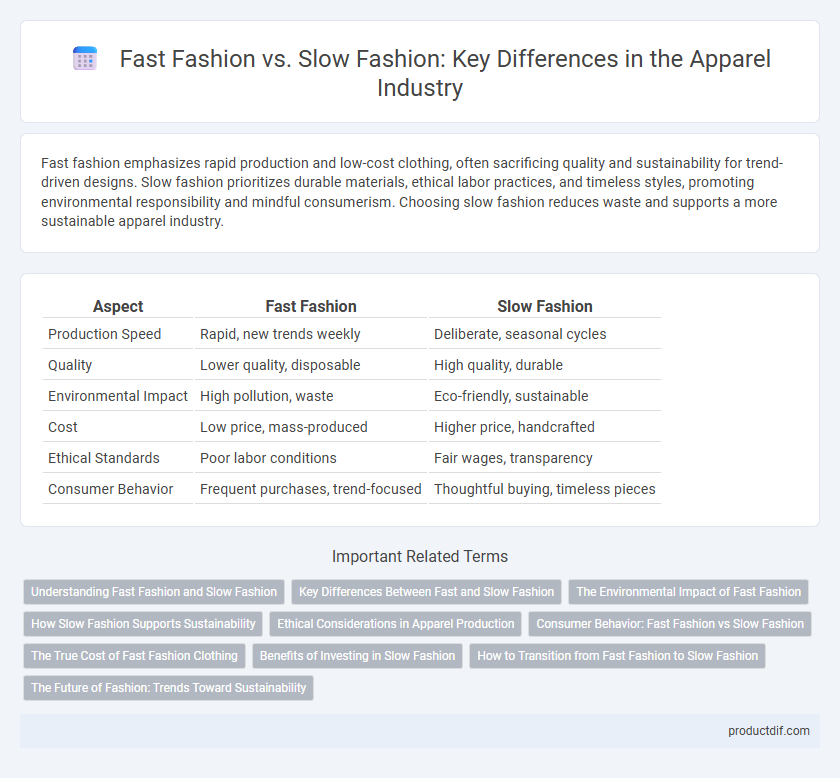Fast fashion emphasizes rapid production and low-cost clothing, often sacrificing quality and sustainability for trend-driven designs. Slow fashion prioritizes durable materials, ethical labor practices, and timeless styles, promoting environmental responsibility and mindful consumerism. Choosing slow fashion reduces waste and supports a more sustainable apparel industry.
Table of Comparison
| Aspect | Fast Fashion | Slow Fashion |
|---|---|---|
| Production Speed | Rapid, new trends weekly | Deliberate, seasonal cycles |
| Quality | Lower quality, disposable | High quality, durable |
| Environmental Impact | High pollution, waste | Eco-friendly, sustainable |
| Cost | Low price, mass-produced | Higher price, handcrafted |
| Ethical Standards | Poor labor conditions | Fair wages, transparency |
| Consumer Behavior | Frequent purchases, trend-focused | Thoughtful buying, timeless pieces |
Understanding Fast Fashion and Slow Fashion
Fast fashion prioritizes rapid production and low-cost, trendy apparel, often resulting in higher environmental impact and unethical labor practices. Slow fashion emphasizes sustainability, quality, and ethical manufacturing, promoting durability and reducing waste in the apparel industry. Consumers increasingly choose slow fashion to support eco-friendly materials and fair trade standards, contrasting with the disposable nature of fast fashion garments.
Key Differences Between Fast and Slow Fashion
Fast fashion emphasizes rapid production, low costs, and trend replication, often sacrificing quality and sustainability for speed and affordability. Slow fashion prioritizes craftsmanship, ethical production, and durable materials, promoting environmental responsibility and timeless style over mass consumption. Key differences include production speed, environmental impact, consumer mindset, and garment longevity.
The Environmental Impact of Fast Fashion
Fast fashion generates over 92 million tons of textile waste annually, contributing significantly to global pollution and landfill overflow. The production processes rely heavily on non-renewable resources, emitting approximately 1.2 billion tons of greenhouse gases each year. In contrast, slow fashion prioritizes sustainable materials and ethical manufacturing, drastically reducing environmental footprints.
How Slow Fashion Supports Sustainability
Slow fashion emphasizes quality, durability, and ethical production, significantly reducing textile waste and environmental pollution compared to fast fashion's rapid consumption model. By prioritizing natural fibers, fair labor practices, and timeless designs, slow fashion minimizes carbon footprints and conserves resources such as water and energy. This approach fosters sustainable consumer habits and promotes a circular economy within the apparel industry.
Ethical Considerations in Apparel Production
Fast fashion prioritizes rapid production and low cost, often resulting in exploitative labor practices and environmental degradation due to excessive waste and resource consumption. Slow fashion emphasizes ethical considerations by promoting fair wages, safe working conditions, and sustainable materials, reducing the carbon footprint and encouraging conscious consumerism. Brands adopting slow fashion principles invest in transparent supply chains and durable, high-quality garments to minimize harm to workers and the planet.
Consumer Behavior: Fast Fashion vs Slow Fashion
Consumer behavior in fast fashion is driven by frequent purchases, affordability, and trend responsiveness, leading to high turnover and increased waste. In contrast, slow fashion consumers prioritize quality, sustainability, and ethical production, often investing in timeless pieces that reduce environmental impact. Awareness of social and environmental issues significantly influences slow fashion adoption, promoting mindful consumption and brand loyalty.
The True Cost of Fast Fashion Clothing
Fast fashion clothing often comes at the expense of environmental degradation, including excessive water usage and toxic chemical pollution, as well as unethical labor practices in developing countries. The rapid production cycles prioritize low costs and high turnover, leading to massive textile waste and carbon emissions. In contrast, slow fashion emphasizes sustainable materials, fair wages, and durability, reducing the true social and ecological cost embedded in each garment.
Benefits of Investing in Slow Fashion
Investing in slow fashion promotes sustainable sourcing and ethical labor practices, reducing environmental impact and supporting fair wages. High-quality materials and timeless designs extend garment lifespan, decreasing waste and long-term costs for consumers. Slow fashion fosters transparency and accountability in the apparel supply chain, encouraging responsible consumption and resource conservation.
How to Transition from Fast Fashion to Slow Fashion
Transitioning from fast fashion to slow fashion involves prioritizing quality over quantity by investing in durable, timeless pieces that reduce waste and environmental impact. Consumers should support ethical brands committed to sustainable production practices, transparency, and fair labor conditions. Embracing mindful purchasing habits, such as buying secondhand, repairing garments, and reducing impulsive shopping, fosters a more sustainable wardrobe aligned with slow fashion principles.
The Future of Fashion: Trends Toward Sustainability
Fast fashion accelerates production cycles, prioritizing affordability and trends but often generates significant environmental waste and ethical concerns. Slow fashion emphasizes sustainable materials, fair labor practices, and durability, aiming to reduce the ecological footprint of apparel. Increasing consumer demand for eco-friendly textiles and circular fashion models signals a transformative shift toward sustainability in the apparel industry.
Fast fashion vs slow fashion Infographic

 productdif.com
productdif.com